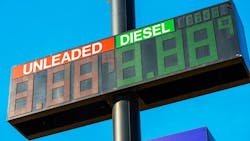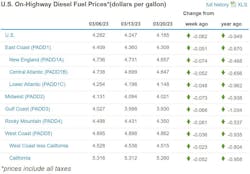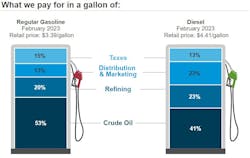Streak of diesel declines reaches seven weeks
The U.S. average price for diesel continued its descent for a seventh week as the fuel fell another 6.2 cents to $4.185 per gallon, according to U.S. Energy Information Administration (EIA) data for the week of March 20. And with per-barrel oil prices plummeting on recently shaky financial markets, diesel may soon fall nationally to $4 per gallon or lower, reaching those levels much sooner than the late 2023 and 2024 timeframe that EIA has predicted.
The 6.2-cent decline this week, which followed a 3.5-cent drop last week, also means that U.S. diesel is almost $1 (94.9 cents) cheaper than it was a year ago—a significant achievement but one skewed by the monster price spikes last spring through the middle of last summer following the Russian invasion of Ukraine.
See also: Why diesel still matters
Additionally, motor club AAA is showing its U.S. diesel average down 5.5 cents to $4.284 on March 21. AAA had prices trending down most of last week into this one.
The price of diesel fell in all U.S. regions, per EIA’s breakdown, but declined by more in three EIA regions and one subregion. The fuel was down the most in the Rocky Mountain region (8.1 cents lower to $4.35 per gallon), followed by the Midwest (down 7.3 cents to $4.021) and the Gulf Coast (6.8 cents lower to $3.93 per gallon). The fuel slid 7.4 cents to $4.657 in the New England subregion of the East Coast, while overall in the East, the fuel fell 5.1 cents to $4.309 per gallon.
Meanwhile, the U.S. average price for gasoline, used widely by consumers and some smaller commercial fleets and work truckers, fell 3.4 cents to $3.422 per gallon for the week of March 20, according to EIA, which also has gas 81.7 cents lower than it was nationwide a year ago. Gasoline also fell in every region and all but one subregion, the Lower Atlantic, EIA reported.
Oil slumps amid financial sector scramble
Substantially cheaper fuel—both diesel and gasoline—might be on the way because oil prices have been plummeting, especially in the last week. Both Brent crude and West Texas Intermediate are well below $80 per barrel, with WTI approaching $65 on March 21 and Brent hovering around $75, both lower than recent levels and far below oil prices last year.
See also: Spot market slumps in February
Futures contracts for WTI crude for April have fallen 2.34% and Brent futures are down around 2.4%. Oil production and refining also are steady, contributing to cheaper crude. EIA also predicted that oil prices would fall for the rest of this year into 2024.
Analysts are mainly attributing the recent oil-price collapse to new uncertainty in the financial sector, which has been roiled by bank failure, particularly Silicon Valley Bank's collapse, and the instability at Credit Suisse, which Swiss banking giant UBS had to rescue from failure.
In the same blog post, GasBuddy reported that diesel prices at the top 10% of stations in the country averaged $5.32 per gallon this week, while the bottom 10% averaged $3.56 per gallon. The states with the lowest average diesel prices were Oklahoma ($3.70), Texas ($3.75), and Kansas ($3.87), according to GasBuddy, while those with the highest average diesel prices were Hawaii ($5.94), California ($5.46), and Maine ($5.13).
About the Author
Scott Achelpohl
Managing Editor
Scott Achelpohl is a former FleetOwner managing editor who wrote for the publication from 2021 to 2023. Since 2023, he has served as managing editor of Endeavor Business Media's Smart Industry, a FleetOwner affiliate.



